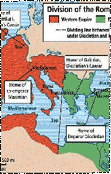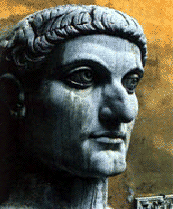| |

|
|

|
2
OF 2 |
|
 In
Rome itself, Christians were imprisoned and tortured, or thrown
into the arena to be devoured by lions. But persecution simply gave
the sect even greater cohesion and powers of resistance - a fact
not lost on Emperor Constantine. In 313 Constantine granted freedom
of worship to all religions, and Christianity later became the state
religion. In
Rome itself, Christians were imprisoned and tortured, or thrown
into the arena to be devoured by lions. But persecution simply gave
the sect even greater cohesion and powers of resistance - a fact
not lost on Emperor Constantine. In 313 Constantine granted freedom
of worship to all religions, and Christianity later became the state
religion.
Before the end of the fourth century, a patriarchate was established
in Constantinople with ecclesiastical jurisdiction over much of
the Greek East. The basilica of Hagia Sophia (Holy Wisdom), whose
construction in Constantinople was ordered by Emperor Justinian
in 532, became the spiritual focus of Greek Christendom.
Constantine made an immense contribution to the spread of Christianity,
but he failed in one of his primary aims. He wanted to unite all
Christians in one Church, but in fact he succeeded in splitting
them.The Christians of the West claimed that the Pope in Rome was
the leader of Christendom. Those in the East recognised the Patriarch
of Constantinople as their leader. These two forms became the Roman
Catholic Church and the Eastern Ortodox Church. The Byzantine emperors
maintanied a large Christian empire covering much of Asia and North
Africa until a new dynamic religious force apperaed in the East.
This was the religious faith of Islam
 In
the early seventh century, the emperor in Constantinople presided
over a realm that included not only Greece and Anatolia but Syria,
Egypt, Sicily, most of Italy, and the Balkans, with outposts across
North Africa as far as Morocco. Anatolia was the most productive
part of this extensive empire and was also the principal reservoir
of manpower for its defense. With the loss of Syria to Muslim conquest
in the seventh century, Anatolia became the frontier as well as
the heartland of the empire. The military demands imposed on the
Byzantine state to police its provinces and defend its frontiers
were enormous, but despite the gradual contraction of the empire
and frequent political unrest, Byzantine forces generally remained
strong until the eleventh century. In
the early seventh century, the emperor in Constantinople presided
over a realm that included not only Greece and Anatolia but Syria,
Egypt, Sicily, most of Italy, and the Balkans, with outposts across
North Africa as far as Morocco. Anatolia was the most productive
part of this extensive empire and was also the principal reservoir
of manpower for its defense. With the loss of Syria to Muslim conquest
in the seventh century, Anatolia became the frontier as well as
the heartland of the empire. The military demands imposed on the
Byzantine state to police its provinces and defend its frontiers
were enormous, but despite the gradual contraction of the empire
and frequent political unrest, Byzantine forces generally remained
strong until the eleventh century.
The tide turned in the 9th century under
dynasty of emperors which included Michael III (842-67), and later
Basil's dynasty, which held the throne of Byzantium for the next
two centuries. Basil's successors extended the empire's boundaries
to the Euphrates, and made considerable inroads into Bulgaria.
The empire's revival continues under Basil II (976-1025), a man
of strong will and courage , whose reign gave Byzantium a period
of prosperity and expension as great as that enjoyed under Justinian.
So succesful was his campaign agains the Bulgars in the Balkans
that he became known as Basil the Bulgar-Slayer. When Basil died
in 1025, the empire had reached a peak of success, though at the
cost of overstraining its economy.
Byzan Church

|
2
OF 2 |
|
|
|


